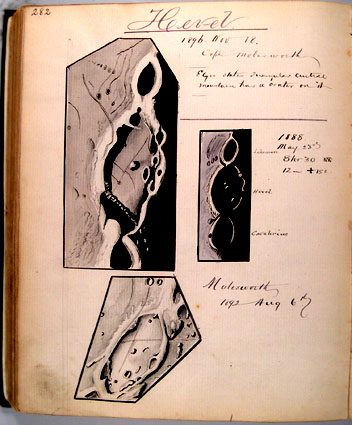Difference between revisions of "September 1, 2004"
| (8 intermediate revisions by the same user not shown) | |||
| Line 1: | Line 1: | ||
__NOTOC__ | __NOTOC__ | ||
=Hundred Year Old Hevelius= | =Hundred Year Old Hevelius= | ||
| + | <!-- Start of content --> | ||
<br> | <br> | ||
<table width="85%" border="0" align="center" cellpadding="6" cellspacing="2"> | <table width="85%" border="0" align="center" cellpadding="6" cellspacing="2"> | ||
| Line 11: | Line 12: | ||
<table width="80%" border="0" align="center" cellpadding="8"> | <table width="80%" border="0" align="center" cellpadding="8"> | ||
<tr> | <tr> | ||
| − | <td><div align="center" class="main_sm">Image Credit: [mailto:tychocrater@yahoo.com Chuck Wood ]</div></td> | + | <td><div align="center" class="main_sm"> |
| + | Image Credit: [mailto:tychocrater@yahoo.com Chuck Wood ] | ||
| + | </div></td> | ||
</tr> | </tr> | ||
</table> | </table> | ||
| Line 18: | Line 21: | ||
<p class="story" align="center"><b>Hundred Year Old Hevel</b></p> | <p class="story" align="center"><b>Hundred Year Old Hevel</b></p> | ||
<p class="story" align="left"> | <p class="story" align="left"> | ||
| − | With our multi-hundred dollar eyepieces, goto telescopes, electronic cameras and clever software we see and record the Moon better than ever before. Oh yeah? Compare the top left drawing of Hevel (the name before latinization gentrified it to Hevelius), made in 1896 by one Capt. Molesworth, with your own observations. Have you seen the crossing rilles on the crater floor? The very best telescopic image ever of [ | + | With our multi-hundred dollar eyepieces, goto telescopes, electronic cameras and clever software we see and record the Moon better than ever before. Oh yeah? Compare the top left drawing of Hevel (the name before latinization gentrified it to Hevelius), made in 1896 by one Capt. Molesworth, with your own observations. Have you seen the crossing rilles on the crater floor? The very best telescopic image ever of [[May_6,_2004|Hevelius]] confirms the Capt's discovery and does show some additional rilles. We should not ignore the work of old time observers. Some had excellent telescopes, sharp eyes and good drafting skills. What we do have now that they didn't is a good understanding of the geologic processes that made the lunar landscapes we study. Today's LPOD is another page from the 1890s lunar diary of [[April_19,_2004|Walter Goodacre]]. </p> |
<p class="story" align="left"> </p> | <p class="story" align="left"> </p> | ||
<blockquote> | <blockquote> | ||
| Line 24: | Line 27: | ||
</blockquote> | </blockquote> | ||
<p><b>Related Links: </b><br> | <p><b>Related Links: </b><br> | ||
| − | [ | + | [[March_6,_2004|Goodacre's Imbrium]] </p> |
| − | <p><b>Tomorrow's LPOD:</b> Ray-Swept Stofler</p> | + | <p><b>Yesterday's LPOD:</b> [[August 31, 2004|Archimedes and his Mountains]] </p> |
| + | <p><b>Tomorrow's LPOD:</b> [[September 2, 2004|Ray-Swept Stofler]] </p> | ||
<p> </p> | <p> </p> | ||
</tr> | </tr> | ||
| Line 37: | Line 41: | ||
<td><p align="center" class="main_titles"><b>Author & Editor:</b><br> | <td><p align="center" class="main_titles"><b>Author & Editor:</b><br> | ||
[mailto:tychocrater@yahoo.com Charles A. Wood]</p> | [mailto:tychocrater@yahoo.com Charles A. Wood]</p> | ||
| − | < | + | <!-- Cleanup of credits --> |
| − | + | <!-- Cleanup of credits --> | |
| − | < | + | <!-- Cleanup of credits --> |
| − | + | <!-- Cleanup of credits --> | |
| − | < | + | <!-- Cleanup of credits --> |
| − | + | <!-- Cleanup of credits --> | |
| − | < | + | <!-- Cleanup of credits --> |
| − | + | <!-- Cleanup of credits --> | |
| − | + | <!-- Cleanup of credits --> | |
| − | + | {{wiki/ArticleFooter}} | |
| − | < | ||
| − | |||
| − | ---- | ||
| − | |||
| − | |||
Latest revision as of 13:38, 15 March 2015
Hundred Year Old Hevelius
Image Credit: Chuck Wood |
|
Hundred Year Old Hevel With our multi-hundred dollar eyepieces, goto telescopes, electronic cameras and clever software we see and record the Moon better than ever before. Oh yeah? Compare the top left drawing of Hevel (the name before latinization gentrified it to Hevelius), made in 1896 by one Capt. Molesworth, with your own observations. Have you seen the crossing rilles on the crater floor? The very best telescopic image ever of Hevelius confirms the Capt's discovery and does show some additional rilles. We should not ignore the work of old time observers. Some had excellent telescopes, sharp eyes and good drafting skills. What we do have now that they didn't is a good understanding of the geologic processes that made the lunar landscapes we study. Today's LPOD is another page from the 1890s lunar diary of Walter Goodacre.
Related Links: Yesterday's LPOD: Archimedes and his Mountains Tomorrow's LPOD: Ray-Swept Stofler
|
Author & Editor: COMMENTS?Register, Log in, and join in the comments.
|




